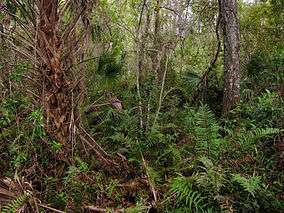Strand swamp
A strand swamp or strand is a type of swamp in Florida that forms a linear drainage channel on flatlands. A forested wetland ecological habitat, strands occur on land areas with high water tables where the lack of slope prevents stream formation. Strands are more linear than the cypress dome swamps that form in more rounded depressions and are fairly similar to floodplain swamps that form further north along streams and rivers.[1][2]

For the most part, strand swamps occur south of Lake Okeechobee.[2] Notable strand swamps include the Fakahatchee Strand and Corkscrew Swamp,[2] where the trees are up to 700 years old and 100 feet (30 m) tall.[1] The Fakahatchee Strand is a tree-filled channel of slowly moving water that is 20 miles (32 km) long and 5 miles (8 km) wide.[3]
Strand swamps are often dominated by bald cypress (Taxodium distichum). Shallower strand swamps may contain pond cypress (Taxodium ascendens).[2] When either of these trees dominate, the strand is known as a "cypress strand".[1] Outside of protected areas, most old-growth cypress trees in Florida along streams or lakes have been harvested for their rot-resistant wood.[4]
Beneath a strand swamp are layers of peat. Established strand swamps with a large amount of vegetation have deep peat layers. These deep peat layers can serve as a wick to draw water from underground into the swamp during droughts.[2]
List of species
Undisturbed strand swamps support a number of plant species:
|
|
Strand swamps are also home to a number of animals, including Florida redbelly turtle (Pseudemys nelsoni), wood stork (Mycteria americana), wild turkey (Meleagris gallopavo), Florida black bear (Ursus americanus floridanus), and the endangered Florida panther.[1]
References
- Whitney, Eleanor Noss; Means, D. Bruce; Rudloe, Anne (2004). Priceless Florida: Natural Ecosystems and Native Species. Pineapple Press. p. 179.
- "Strand Swamp" (PDF). Florida Natural Area Inventory. Retrieved 2012-05-26.
- Waitley, Douglas; Lohan, Frank (2006). Easygoing Guide to Natural Florida: South Florida. Pineapple Press. p. 137.
- Sunquist, Fiona; Sunquist, Mel; Beletsky, Les (2007). Florida. Interlink Books. p. 19.